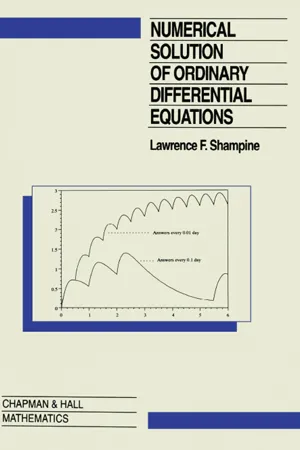
- 632 pages
- English
- ePUB (mobile friendly)
- Available on iOS & Android
eBook - ePub
Numerical Solution of Ordinary Differential Equations
About this book
This new work is an introduction to the numerical solution of the initial value problem for a system of ordinary differential equations. The first three chapters are general in nature, and chapters 4 through 8 derive the basic numerical methods, prove their convergence, study their stability and consider how to implement them effectively. The book focuses on the most important methods in practice and develops them fully, uses examples throughout, and emphasizes practical problem-solving methods.
Frequently asked questions
Yes, you can cancel anytime from the Subscription tab in your account settings on the Perlego website. Your subscription will stay active until the end of your current billing period. Learn how to cancel your subscription.
No, books cannot be downloaded as external files, such as PDFs, for use outside of Perlego. However, you can download books within the Perlego app for offline reading on mobile or tablet. Learn more here.
Perlego offers two plans: Essential and Complete
- Essential is ideal for learners and professionals who enjoy exploring a wide range of subjects. Access the Essential Library with 800,000+ trusted titles and best-sellers across business, personal growth, and the humanities. Includes unlimited reading time and Standard Read Aloud voice.
- Complete: Perfect for advanced learners and researchers needing full, unrestricted access. Unlock 1.4M+ books across hundreds of subjects, including academic and specialized titles. The Complete Plan also includes advanced features like Premium Read Aloud and Research Assistant.
We are an online textbook subscription service, where you can get access to an entire online library for less than the price of a single book per month. With over 1 million books across 1000+ topics, we’ve got you covered! Learn more here.
Look out for the read-aloud symbol on your next book to see if you can listen to it. The read-aloud tool reads text aloud for you, highlighting the text as it is being read. You can pause it, speed it up and slow it down. Learn more here.
Yes! You can use the Perlego app on both iOS or Android devices to read anytime, anywhere — even offline. Perfect for commutes or when you’re on the go.
Please note we cannot support devices running on iOS 13 and Android 7 or earlier. Learn more about using the app.
Please note we cannot support devices running on iOS 13 and Android 7 or earlier. Learn more about using the app.
Yes, you can access Numerical Solution of Ordinary Differential Equations by L.F. Shampine in PDF and/or ePUB format, as well as other popular books in Mathematics & Mathematics General. We have over one million books available in our catalogue for you to explore.
Information
1
The Mathematical Problem
The aim of this chapter is to develop a sense of what kinds of initial value problems can be solved numerically and how to prepare problems for their numerical solution. First we review the “facts of life” about the existence and uniqueness of solutions. It is convenient in the theory of ordinary differential equations (ODEs) to work with problems written in a standard form, and because the codes all expect problems to be presented in this way, we must go into this. Some basic mathematical tools are found in the appendix. The concept of “order” is fundamental to a study of the numerical solution of the initial value problem. Because it may not be familiar to the reader, the elements are developed here. Finally a series of substantial examples are taken up to show how one might be able to deal with problems that do not fit neatly into the standard theory of ODEs and their numerical solution. Some of the examples will be used throughout the book for illustrative purposes.
§1 Existence, Uniqueness, and Standard Form
We begin by considering the initial value problem itself to see what kinds of problems are meaningful and what kinds we might hope to solve numerically. Even very simple problems that can be understood with arguments from calculus show what can happen. If F(x) is continuous on an interval [a, b], the equation
(1.1) |
has a solution given by the fundamental theorem of calculus,
This is a solution of the differential equation (1.1) for any value of the constant B, so to select a particular solution some additional information must be supplied. There are a number of ways this might be done. Although several will appear in this chapter, the most common, and the subject of this book, is to specify the initial value
(1.2) |
The two requirements (1.1) and (1.2) make up an initial value problem for an ordinary differential equation. There is a solution and only one, namely
In general, an initial value problem for an ordinary differential equation has the form
It is assumed that F(x, y) is continuous in both variables. A solution is a function y(x) that is continuous and has a continuous first derivative on [a, b] (in symbols, y ∈ C1 [a, b]), satisfies y(a) = A, and satisfies
for each x in [a, b]. The contin...
Table of contents
- Cover
- Half Title
- Title Page
- Copyright Page
- Table of Contents
- Preface
- Chapter 1 The Mathematical Problem
- Chapter 2 Discrete Variable Methods
- Chapter 3 The Computational Problem
- Chapter 4 Basic Methods
- Chapter 5 Convergence and Stability
- Chapter 6 Stability for Large Step Sizes
- Chapter 7 Error Estimation and Control
- Chapter 8 Stiff Problems
- Problems
- References
- Appendix Some Mathematical Tools
- Index